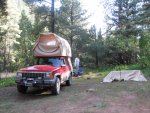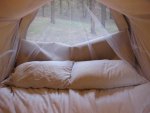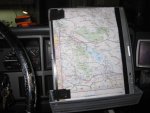Somewhere above I mentioned that I'd talk about the bug netting.
The roof top tent is basically open to bugs without special efforts. They can always fly in at the bottom of the tent even if both ends are closed. I purchased a bug net designed to be suspended above a cot. I do not remember the exact source but it was something like
http://www.campmor.com/outdoor/gear/Product___86662
The net attaches to the inside of the canopy and can be seen through the open flap in the picture below.

This net wasn't very expensive. It was basically a rectangular box with the bottom open. In the picture below you can see the seams of the rectangle top at right and left. It turned out that the rectangle was wider than the 4.5 feet width of the jeep rack. I simply sewed 3 Velcro pads at each end of the canopy and at the appropriate points on the rectangle top to give the proper draping. By lucky chance the rectangle was just slightly shorter than the length of the canopy so it was easy to get it stretched lengthwise.

Here's a closer picture looking out of the front panel. The netting simply stuffs between the rack edges and the inside of the canopy making a bug-proof seal.

Below is a picture of the Velcro attach point at front panel center. There are two similar points out of the picture to right and left. Setup is easy. I simply leave the bug net on top of the bed when I collapse the tent. Once the tent is erected I get inside, zip the end panels in and then just re-attach the bug net by pressing the tabs on the net against the Velcro pads.

Picture below is looking out the door panel at the rear of the vehicle. Entry or exit occurs between the bug net and the roof rack. There's plenty of net so this isn't a problem although the net sometimes gets tangled and one or two of the three rear tabs get pulled loose.

Well that's it for the bug netting. It works well, doesn't weight much, and keeps the mosquitoes off. It's optional and I don't take it along on desert trips.
Next edition I'll show the bug net for the Sombrero.
The roof top tent is basically open to bugs without special efforts. They can always fly in at the bottom of the tent even if both ends are closed. I purchased a bug net designed to be suspended above a cot. I do not remember the exact source but it was something like
http://www.campmor.com/outdoor/gear/Product___86662
The net attaches to the inside of the canopy and can be seen through the open flap in the picture below.
This net wasn't very expensive. It was basically a rectangular box with the bottom open. In the picture below you can see the seams of the rectangle top at right and left. It turned out that the rectangle was wider than the 4.5 feet width of the jeep rack. I simply sewed 3 Velcro pads at each end of the canopy and at the appropriate points on the rectangle top to give the proper draping. By lucky chance the rectangle was just slightly shorter than the length of the canopy so it was easy to get it stretched lengthwise.
Here's a closer picture looking out of the front panel. The netting simply stuffs between the rack edges and the inside of the canopy making a bug-proof seal.
Below is a picture of the Velcro attach point at front panel center. There are two similar points out of the picture to right and left. Setup is easy. I simply leave the bug net on top of the bed when I collapse the tent. Once the tent is erected I get inside, zip the end panels in and then just re-attach the bug net by pressing the tabs on the net against the Velcro pads.
Picture below is looking out the door panel at the rear of the vehicle. Entry or exit occurs between the bug net and the roof rack. There's plenty of net so this isn't a problem although the net sometimes gets tangled and one or two of the three rear tabs get pulled loose.
Well that's it for the bug netting. It works well, doesn't weight much, and keeps the mosquitoes off. It's optional and I don't take it along on desert trips.
Next edition I'll show the bug net for the Sombrero.
Attachments
Last edited:











